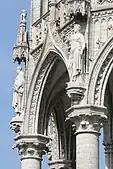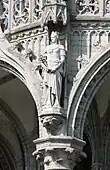.jpg.webp) | |
| 50°53′26″N 4°21′12″E / 50.89056°N 4.35333°E | |
| Location | Place de la Dynastie / Vorstenhuisplein B-1000 City of Brussels, Brussels-Capital Region, Belgium |
|---|---|
| Designer | Louis De Curte |
| Beginning date | 1878 |
| Completion date | 1881 |
| Dedicated to | King Leopold I |
The Monument to the Dynasty (French: Monument à la Dynastie, Dutch: Monument voor de Dynastie) is a monument erected in Brussels, Belgium, in memory of King Leopold I, first King of the Belgians. The monument is located in Laeken Park, on the Place de la Dynastie/Vorstenhuisplein, on top of a 50-metre-high (160 ft) hill. It completes the monumental axis, which starts from the portal of the Royal Palace of Laeken, and which leads to the monument after crossing the Avenue du Parc Royal/Koninklijk Parklaan via the Avenue de la Dynastie/Vorstenhuislaan.[1]
History
The monument was designed by the architect Louis De Curte in a neo-Gothic style. It was built from 1878 to 1881 on behalf of King Leopold II, who had the monument erected in honour of the founding of the dynasty by his father, King Leopold I, whom he had succeeded as King of the Belgians in 1865. The monument should have been completed in 1880, during the opening of Laeken Park, on the occasion of the fiftieth anniversary of the Kingdom of Belgium.[2][1]
The monument was renovated in 2001 on the occasion of the Belgian presidency of the European Union. It remains closed to the public for fear of vandalism.
 Inauguration of the Monument to the Dynasty in Laeken Park, 21 July 1880, etching by Armand Heins from L'Illustration nationale[3]
Inauguration of the Monument to the Dynasty in Laeken Park, 21 July 1880, etching by Armand Heins from L'Illustration nationale[3] The Monument to the Dynasty in 1880, etching by Armand Heins from L'Illustration nationale[2]
The Monument to the Dynasty in 1880, etching by Armand Heins from L'Illustration nationale[2] Statue of King Leopold I in 1880, etching by Joseph Smeeton and Auguste Tilly from L'Illustration nationale
Statue of King Leopold I in 1880, etching by Joseph Smeeton and Auguste Tilly from L'Illustration nationale
Iconography
Leopold I
In the centre of a nine-bay gallery, each symbolising one of the nine original Belgian Provinces, is a sculpture of King Leopold I by Guillaume Geefs,[1] who also made the statue of Leopold I on the Congress Column. On this substructure rests an almost 50-metre-high (160 ft) spire, topped with a golden crown. Above the statues of the nine Belgian Provinces, a Leo Belgicus holds the coat of arms of the province in question. At the rear of the monument, on the north side, a staircase gives access to a walk above the peristyle. This walk passes under the flying buttresses decorated with small gargoyles.
Nine provinces
The statue of the king is protected by a canopy in the shape of a perfect enneagon resting on a stepped base. This unusual shape made it possible to represent the nine provinces that made up Belgium at the time. The allegories representing them were entrusted to a collection of artists who were inspired by the drawings of Georges Houtstont: the Province of Namur is symbolised by Metallurgy (Thomas Vinçotte), the Province of Luxembourg by Hunting (Albert Desenfans), the Province of Liège by Armory (Adolphe Fassin), the Province of Limburg by Agriculture (Antoine van Rasbourg), the Province of Antwerp by Trade and Navigation (Frans Deckers), the Province of Brabant by the Royal scepter (Charles van der Stappen), the Province of East Flanders by Spinning mills and Horticulture (Gérard van der Linden), the Province of West Flanders by Fishing (Henri Pickery), and the Province of Hainaut by Coal (Charles Brunin).[1]
Spire
The spire is 50 metres (160 ft) high, which refers to the age of the kingdom in 1880, and bears a crown, referring to the kingdom and the king.
 Statue of King Leopold I by Guillaume Geefs
Statue of King Leopold I by Guillaume Geefs Allegories of the Province of Liège (left) and Province of Limburg (right) by Adolphe Fassin and Antoine-Joseph Van Rasbourgh
Allegories of the Province of Liège (left) and Province of Limburg (right) by Adolphe Fassin and Antoine-Joseph Van Rasbourgh Allegory of the Province of Brabant by Charles Van der Stappen
Allegory of the Province of Brabant by Charles Van der Stappen
See also
References
Citations
- 1 2 3 4 "Monument à la Dynastie – Inventaire du patrimoine architectural". monument.heritage.brussels (in French). Retrieved 4 December 2023.
- 1 2 Goedleven 1988, p. 64.
- ↑ Goedleven 1988, p. 65.
Bibliography
- Goedleven, Edgard (1988). Les Serres royales de Laeken (in French). Brussels: Duculot, Inbel. ISBN 978-2-8011-0799-7.
External links
 Media related to Monument of Leopold I, Brussels at Wikimedia Commons
Media related to Monument of Leopold I, Brussels at Wikimedia Commons